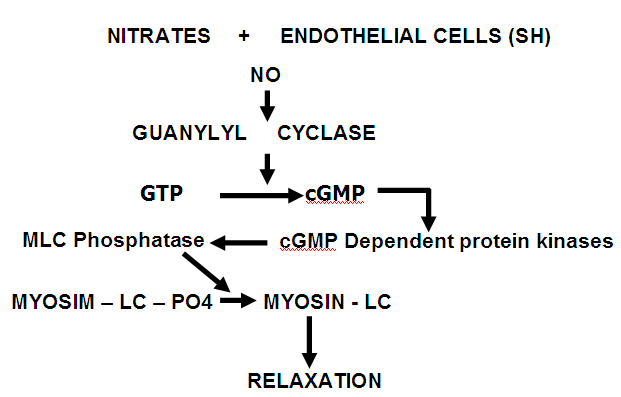Mechanism of Action
Nitrates are converted into NO by glutathione S transferrase
Phosphorylation of myosin light chain is important along with Ca++ ions. Thus relaxation can be caused by:
- Decreased phosphorylation
- Decreased calcium
Tolerance to nitrates develops when given excessively because of depletion of sulphydral groups.
Determinants Of Myocardial O2 Consumption
1. Wall stress
a. Intraventricular pressure
b. Ventricular volume
c. Wall thickness
2. heart rate
3. contractility
Effect Of Ntrates
1. Reduction of pre-load
2. reduction of after load
3. redistribution of blood to myocardium
4. dilatation of coronary vessels
Hemodynamic Anti-Anginal Effects
What increases stress on heart??
When there is increased intraventricular pressure,
- venous return increases as more filling occurs during diastole
- If arterial pressure increases, heart has to pump blood against higher pressure, thus systolic stress increases.
- Due to greater ventricular volume, more blood in the ventricles causes more stress. When ventricles contract, more pressure is exerted towards centre, subendocardial vessels are compressed more. Wall thickness increases, increasing the wall stress.
What causes relaxation??
In low doses, nitrates have venodilatory effects. The venous return decreases, decreasing the diastolic wall stress.
In absence of cardiac failure, cardiac output decreaes.
Also beneficial in CCF, as cardiac output may increase. Greater concentrations of enzymes are present in veins for converting nitrates into NO.
At higher concentration, arteries also dilate, decreasing TPR and systolic wall stress.
Redistribution of drug
Epicardial vessels are less compressed than the subendocardial vessels. Both are connected. When wall stress is decreased, blood flow from epicardial to subendocardial vessels improves, alleviating the symptoms.
Coronary vasodilatation
Coronary vasodilatation does take place but effect is negated by decrease in cardiac output and blood pressure.
Improvement is only due to first three effects.
Also affect every other part. Relaxation of GIT, genitourinary, respiratory systems occurs, which has no therapeutic importance.
Esophageal spasm may be released. Its symptoms mimic heart disease, when relaxed, we might think of ischemic heart disease. ECG changes may also mislead us.
Another effect of nitrates is on platelets. They prevent aggregation (cGMP mediated), this has no therapeutic value. Thus anticoagulants like aspirin, have to be given in addition.
Adverse Effects
1. Vasodilatation
a. In cerebral vessels leading to headache
b. In face leading to flushing
c. Postural hypotension leading to dizziness and stimulation of sympathetic outflow, reflex tachycardia occurs, which can offset beneficial effects.
2. Skin rashes –transdermal nitroglycerine patches may lead to rashes
3. Tolerance –tachyphylaxis as rapidly develops.
After a few hours of therapy, effects are reduced due to depletion of sulphydral groups.
4. Salt and water retention might occur, leading to increase in blood volume, which reverts beneficial effects.
5. Free oxygen radicals are produced.
6. Reflex increase in contractility
7. Monday morning disease
Individuals working in industries, like explosives (nitroglycerine) when go to work, start experiencing headache, dizziness because of nitrates. Tolerance develops within 1-2 days. When they return after weekend, some symptoms reappear.
Treatment is started at a lower dose of nitrates and is gradually increased. Sublingual tablets are taken in acute angina. When swallow immediately, aspirin is taken for headache.
Tolerance is overcome by nitrate free interval everyday, done by not giving nitrates at night.
Drug Interactions
- Erectile dysfunction due to Sildenafil (Viagra), death may occur if taken with nitrates.
- Phosphor esterase inhibitors, isoform 5 inhibited
- Levels of cGMP rise, nitrates may lead to severe hypotension
- After MI there should be 6 hours nitrate free interval
Pharmacokinetics
Bioavailability is less than 10-20% because of liver enzyme nitrate reductase. Half life of parent compound is only 8-10 minutes. In acute attack, glyceryl nitrate is given sublingually to avoid 1st pass metabolism, but cannot be given excessively by this route.
If want to give excessively, oral route is chosen. Dose is increased so that 10-20% is enough to produce effects. Metabolites retain their activity and are used in certain cases (may be present up to 100%)
Excretion occurs by the kidneys.
Uses
Beneficial effects are due to veins and arterioles, decreasing the preload and afterload, as a result of which redistribution of blood from epicardial to endocardial vessels occurs.
- Stable angina pectoris
- Unstable angina pectoris
- Vasospastic angina –dilatation of coronary vessels, beta agonists although affective but not used here because they do not produce vasodilatation
Continue Reading
Drug Treatment of Ischemic Heart Disease
Calcium Channel Blockers in Ischemic Heart Disease
Browse all articles on Cardiovascular System
 howMed Know Yourself
howMed Know Yourself





